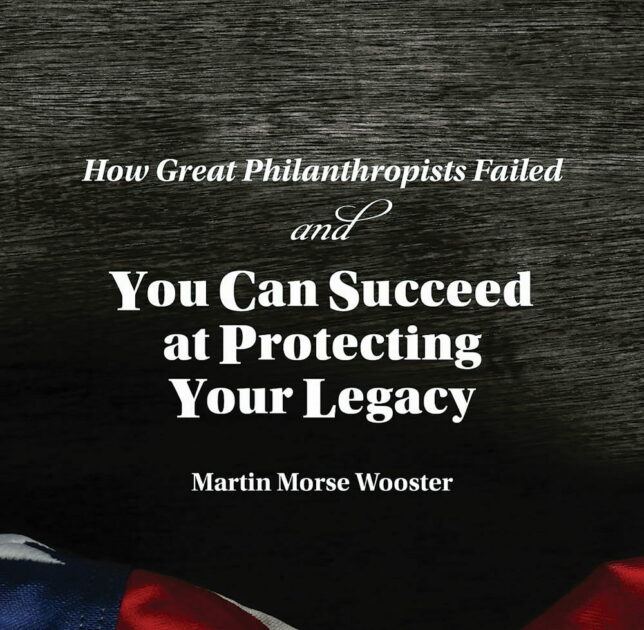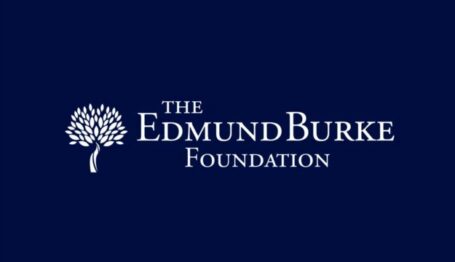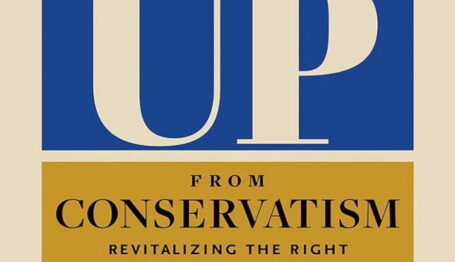Special Report
Martin Morse Wooster: Big Martin vs. Big Philanthropy
A brilliant eccentric who battled Big Philanthropy and Big Government
 His best book on giving, and I’m confident the book that he considered his magnum opus, was originally entitled The Problem of ‘Donor Intent.’ It was first published by Capital Research Center in 1994 but was revised in 1998 and 2007, and its fourth edition appeared in 2017 as How Great Philanthropists Failed and How You Can Succeed at Protecting Your Legacy. Credit: Amazon. License: https://amzn.to/3HL6tcS.
His best book on giving, and I’m confident the book that he considered his magnum opus, was originally entitled The Problem of ‘Donor Intent.’ It was first published by Capital Research Center in 1994 but was revised in 1998 and 2007, and its fourth edition appeared in 2017 as How Great Philanthropists Failed and How You Can Succeed at Protecting Your Legacy. Credit: Amazon. License: https://amzn.to/3HL6tcS.

Martin Morse Wooster, 1957–2022 (full series)
Book Man | Martin’s Genuine “Civic Participation”
Big Martin vs. Big Philanthropy
Big Martin vs. Big Philanthropy
Martin relentlessly hammered Big Philanthropy. On the one hand, he could write with deep appreciation of titans whose entrepreneurial genius allowed them to amass a fortune that would later be, in effect, stolen by grasping left-wingers like Rimel at Pew. On the other hand, he spared no criticism of those who squandered those titans’ philanthropy. One place to see Martin’s fine historical work on America’s most successful businessmen is The Foundation Builders: Brief Biographies of Twelve Great Philanthropists, published by the Philanthropy Roundtable. This concise work includes a chapter on J. Howard Pew, which ends with a quotation from the man that should shame his heirs and the current staff at the Pew Trusts:
What of the future? Charity, a work of love, can exist only when it is free. It is freedom that has effected the miracle of America—intellectual freedom, religious freedom, political freedom, industrial freedom, freedom to dream, to think, to experiment, to invent, to match wits in friendly competition, freedom to be an individual. That is our great American heritage. But freedom is indivisible. Thus if we should lose any one of our freedoms, all the rest would certainly fail.
Although Martin did not begrudge a successful tycoon his large fortune, some of his most penetrating work dissected how harmful that fortune could become in the hands of arrogant people working in Big Philanthropy. Another book not to be missed is his Great Philanthropic Mistakes, which went through two editions under the helpful eye of William Schambra at the Hudson Institute’s Bradley Center for Philanthropy and Civic Renewal. Here Martin skewers such things as the Rockefeller Foundation’s meddling in “population control” and medical education (which did no favors for the poor or people of color), Carnegie’s jump-starting of “public” television, and the Ford Foundation’s “gray areas” program that aspired, but failed, to help poor people. He also criticized Ford’s disastrous meddling in New York City schools at the height of the 1960s, a Big Philanthropy mistake so grand that even a New York Times Magazine author judged it to have been “arguably the most harmful” of all experiments foisted on Gotham in that era of turmoil and decline.
How arrogant was the 1960s Ford Foundation, you ask? Martin has the answer:
A program officer listening to someone at a staff meeting drone on about how the foundation would do little good because government, business, and labor were inflexible and unwilling to change said, “Let’s just buy Rhode Island”—on the grounds that Ford at the time gave away $250 million a year, whereas Rhode Island’s annual budget was only $188 million.
Speaking of philanthropic arrogance, Martin also recalled how Ford president Paul Ylvisaker thought the foundation “could somehow create organizations that would solve the problems of the poor—a view he retained even as the groups were radicalized or struggled to get off the ground.” Similarly, and around the same time, Carnegie proclaimed that commercial television would never produce shows that provided history or art to viewers, so the foundation must push government to unleash “public” television. Even as these words were spoken, cable TV was being born.
A major cause of the harms done by “arrogant philanthropists,” Martin wrote, involves placing “too much value on expertise.” Countless “philanthropic mistakes begin with the premise that a foundation has the one right way to shape the world.” Alas, when foundations do manage to escape this error of “expert” conceit, they often retreat into a different error: timidity leading to mediocrity.
For these reasons and more, Martin understood that it is far easier to earn a fortune than to give it away wisely. His best book on giving, and I’m confident the book that he considered his magnum opus, was originally entitled, The Problem of ‘Donor Intent.’ It was first published by Capital Research Center in 1994 but was revised in 1998, and 2007, and its fourth edition appeared in 2017 as How Great Philanthropists Failed and How You Can Succeed at Protecting Your Legacy.
By this edition, the book had grown to nearly 400 pages of main text and another 50 of endnotes, but its structure was simple. Part I, the longest part by far, spun out the horror stories of great philanthropists who unwisely created permanent foundations, only to have them captured by left-wing bandits who used them not only in ways their benefactors would have abhorred but even attempted to destroy the American arrangement of limited government, free markets, and civil society that made possible the wealth now being hijacked by philanthropoid activists. This part told the stories of how men like Rockefeller, Ford, MacArthur, Carnegie, the Pew brothers, Albert Barnes, and more had their vast wealth taken over by hostile groups of activists and sometimes by their own descendants. As Henry Ford II, the founder’s grandson and the last family member to serve on the Ford Foundation’s board, put it in his famous resignation letter of 1976: “The foundation is a creature of capitalism,” which is “a statement that, I’m sure, would be shocking to many professional staff people in the field of philanthropy. It is hard to discern recognition of this fact in anything the foundation does. It is even more difficult to find an understanding of this in many of the institutions, particularly the universities, that are the beneficiaries of the foundation’s grant programs.” Ford added, “I’m not playing the role of the hard-headed tycoon who thinks all philanthropoids are Socialists and all university professors are Communists. I’m just suggesting to the trustees and the staff that the system that makes the foundation possible very probably is worth preserving.”
Part II of Martin’s book is considerably shorter, because it tells the tales of a handful of foundations who have, thus far, done a good job of preserving their donors’ intent, including the JM Foundation, the Bradley Foundation of Milwaukee, and the Daniels Fund of Colorado. Daniels is in fact one of the even smaller number of foundations who began to swerve from donor intent but was brought back. Now, I’m proud to say, Martin’s book is required reading for Daniels’ board members.
Part III concludes the book and is the shortest of all, giving practical advice to donors on how to avoid the pitfalls so carefully detailed earlier. I had the pleasure of editing this final edition of the book, so I added a short Preface, “How to Read This Book,” explaining that “if you’re a scholar of philanthropy, read every word in this book. If you’re a busy donor, let me save you time by spoiling the plot: You lose.”
In other words, a donor faces very bad odds of having his or her intentions respected after death. The phenomenon poses a fascinating paradox: Entrepreneurial geniuses like Andrew Carnegie, John D. Rockefeller, and Henry Ford built commercial empires larger than the world had ever seen. They produced astronomical returns on investment and were rarely tricked out of their money in business deals. But when they turned to giving that money away, they failed.
To be fair, these entrepreneurs faced terrible obstacles. Wealthy and prestigious colleges, as Wooster documents, have treated donors shamefully. The donors’ own staff and assistants have betrayed the vision of the men and women who gave them the money they now abuse. Even family members have utterly disregarded how their ancestors wanted the fruits of their labor used.
But some of the blame remains on those donors who did not recognize and prepare for the long-term difficulties of philanthropy. Martin succinctly summarizes his general advice in reference to David Packard, who was the brilliant co-founder of Hewlett-Packard and therefore of Silicon Valley itself, and a major supporter of Ronald Reagan. Packard also, as Martin chronicles, helped keep one of Herbert Hoover’s main philanthropic projects—the Hoover Institution at Stanford University—from going off the rails, yet Packard’s own multibillion-dollar foundation today funds endless projects at odds with his vision: “The lessons David Packard provides future donors are timeless: Don’t assume that future generations will respect your wishes. Make your intentions as clear as possible, impose as many restrictions as possible—and, if possible, spend your fortunes within your lifetime.”
Martin added, “Two of the most powerful strategies to maintain donor intent are (1) to term-limit your foundation, or (2), even more radically, to do your giving while you’re living, and if you still have a significant estate at the end of your life, leave it not to a foundation but to charities you trust.”
Here I should mention that Martin wrote a separate brief book entirely on term limits for foundations. In 1998, Capital Research Center published Should Foundations Live Forever? The Question of Perpetuity. You already know his answer, and this study was later worked into the fourth and final edition of Martin’s donor intent book for CRC. Martin also wrote a special report on the problems of giving to universities for the James G. Martin Center for Academic Renewal.
Marvin Olasky glowingly endorsed the fourth edition of Martin’s donor intent book, observing “I dislike the term ‘must reading’ when used about anything other than the Bible, but if you are wealthy and creating a foundation,” Martin’s book is “an almost-must.” Many persons of wealth agreed and would call our offices to track down Martin. We also sent the fourth edition to our own donors, only to have two billionaires request extra copies—if they both heed the book’s advice, Martin will have saved around $25 billion for the team. And more than that, we’ve given away thousands more copies to conservative groups across America, who have used it to spur discussions with their donors about how best to plan their current and future giving.
That means that the eccentric Martin Morse Wooster, though proud of his little platoons at the library, the neighborhood, and the pub, may just end up changing the course of empires of wealth as well as the path of the country he loved and humbly served.
Requiescat in pace.
See also a selection of what his friends and colleagues have said.



